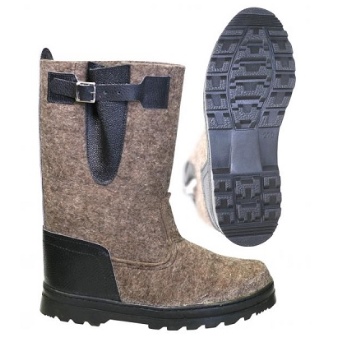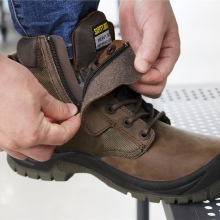All about winter safety shoes

Winter safety footwear is an important component of proper equipment for employees... For people performing their tasks in difficult climatic conditions, maintaining a comfortable body temperature is a priority. To avoid hypothermia, you need to use men's and women's boots for work in the winter in severe frost, as well as insulated work shoes with rubber non-slip soles, which are necessary in ice.



Peculiarities
Special work shoes for severe frosts are necessarily used in difficult climatic conditions, where personnel have to spend a lot of time outdoors. This product category is divided into several classes, according to its purpose: for the north and the coldest climatic zones, for a temperate climate with a slight decrease in atmospheric temperatures. Depending on what materials the winter safety footwear is made of, it can be fully synthetic, combined or natural.
The service life of winter safety footwear largely depends on its performance. On average, it is about 5 years. With longer use, the characteristics of the products gradually deteriorate. Also, insulated footwear can be uniform or industrial, have additional characteristics that increase its resistance to aggressive environments.


Varieties
All types of winter work shoes can be divided into categories according to their purpose and functional characteristics. In particular, it produces women's, men's and unisex products, differing exclusively in the size range. Operating conditions also matter. All certified winter work shoes are standard with non-slip, anti-static soles.
If work is carried out in the forest or outdoors, the temperature can drop to minus 50 degrees, high boots or high boots with rubber soles would be a reasonable choice. The best work shoes for winter must provide the required level of comfort. For this, it is important to choose the right modification for it.



Among the current types, we note the following.
- Boots... They are knee-high or slightly lower, leather bootlegs, PU, TPU, nitrile soles - depending on the version. Natural or artificial fur is responsible for thermal insulation. The boots can have an adjusters at the top, a zipper or Velcro. High fur boots also belong to this category, their main feature is sewing with fur outside.


- Boots. Models are available with TPU, polyurethane, nitrile soles. The insulation here is most often artificial or natural fur; to protect the foot, a metal toe is used.



- Boots and woolen shoes. Products made on a natural woolen base warm well, are lightweight, but are not protected from getting wet. The sole in such products is absent or is made of rubber.


- Combined shoes... It is made of EVA with a rubber sole and Velcro or straps as a fastener. The lining is artificial, often the insulation is sewn into the product.


- Shoe covers. This type of shoe looks like galoshes with a soft top made of waterproof fabric, ties and drawstrings to adjust the volume of the bootleg. Inside, there are usually additional soft liners made of non-woven thermal insulating material.
These are the main types of winter work shoes.In addition, manufacturers can offer other solutions - low shoes, low boots, which differ in the height of the bootleg.


Requirements
The basic requirements for work footwear are regulated by GOST or EN ISO 20345. In particular, it is important that it is suitable for the season, intended for use at low temperatures. Insulated products in this category are produced by European and Russian manufacturers and are certified for compliance with quality standards.
Separate categories of footwear are produced for managers. It is made from premium materials. By the type of execution, footwear for engineers and technicians is most often more versatile - in the form of boots, low boots; for cold climatic zones, boots with insulation with natural fur are purchased. The main brands in this category are from Finland, Sweden, Belgium: Sievi, Jalas, Safety Jogger.



The main requirements for winter work shoes are directly related to the level of their quality and functionality. Among the mandatory points are:
- the presence of non-slip soles;
- waterproof impregnation;
- protection of the ankle and ankle from injury;
- resistance to chemical and mechanical damage;
- the presence of a toe cap;
- compliance with the standard list of approved materials;
- compliance with the professional category.
When choosing winter shoes for specific tasks, all these factors must be taken into account. The professional identity of the staff is especially important. For example, when working with fuels and lubricants, boots and boots must have an oil-resistant sole and surface.



For increased shock loads, a choice of work accessories with a toe cap is a must, and with a risk of punctures, with a Kevlar insole. Winter professional footwear must fully comply with weather and climatic conditions. Among the admissible materials, we note the following.
- Lining... The best choice would be natural wool, fur (synthetic or regular), polyurethane.
- Sole. It should be multi-layer, polyurethane or thermopolyurethane, rubber is allowed. This part is attached to the base mainly by injection molding.
- Top part. For working winter shoes, felt, felt, synthetic fabrics, natural and artificial leather are allowed. A water-repellent coating is required. The top is also made multi-layer, resistant to mechanical damage and other external influences.
All of these requirements must be met. This is the only way to ensure a sufficient level of labor protection when personnel work in difficult climatic and weather conditions.



Criterias of choice
When choosing shoes for work in the winter on the street, it is important to follow a number of rules to exclude possible mistakes. Important selection criteria include the following.
- Natural materials. Even the highest quality synthetic counterparts are not able to warm you better than fur, felt, leather. Whenever possible, natural-based work footwear should be purchased for staff.
- Hygroscopicity... It is very important for winter shoes that the feet do not sweat in them, and the moisture is carried out, preventing freezing. Synthetic upper materials must have membrane properties. Natural and without that provide an optimal thermoregulation regime.
- Insole availability... It should be not only anatomical, but also heat insulating. Modern manufacturers even produce options from foam materials with a "memory effect". Such products are completely individual, allowing you to maintain comfort even when wearing shoes for a long time.
- Wear resistance of the outsole... It should not wear out during the season, losing its performance. A mandatory requirement is the presence of anti-slip components. The best option today is considered to be a two-layer polyurethane or thermopolyurethane sole, which does not change its properties in the cold.
- Top type... A special type of leather is optimally suited for work in the winter period - yuft, which is protected from both mechanical and chemical influences, and is resistant to freezing. It is also permissible to use rubberized materials that are sufficiently elastic even in frost. Felted and felt top options are relevant only for those cases when the labor activity of personnel is not associated with contacts with a wet environment, gasoline, oils.
Regardless of whether employees are wearing boots or boots, it is imperative to pay attention to the correct selection of the size of safety shoes.






It is optimal if it is 0.5 cm or 1/2 of the size longer than the length of a person's foot. Compliance with this rule significantly increases the comfort when wearing products, helps to exclude hypothermia and frostbite of the skin.
For information on how to choose the right work boots for winter, see the next video.













The comment was sent successfully.